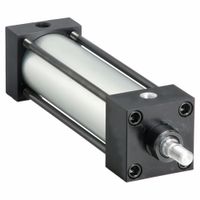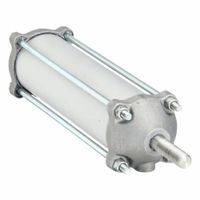Call +(254) 703 030 000 / 751 483 999 / 721 704 777
- Home
- Pneumatics
- Pneumatic Actuators
- Air Cylinders
- Tie Rod Air Cylinders
.....Read More
Frequently Asked Questions
What are tie-rod air cylinders used for?
Tie-rod air cylinders are used in various industrial applications to convert compressed air energy into mechanical motion. They are commonly employed in automation systems, manufacturing processes, and machinery where linear motion is required. These cylinders consist of a piston and rod assembly housed within a cylindrical barrel, with tie rods running along the length to provide structural integrity and support.
Key applications include:
1. **Material Handling**: Tie-rod air cylinders are used in conveyor systems to push, pull, lift, or position materials. They facilitate the movement of goods in assembly lines and packaging operations.
2. **Clamping and Holding**: In manufacturing, these cylinders are used to clamp or hold workpieces in place during machining, welding, or assembly processes, ensuring precision and stability.
3. **Pressing and Stamping**: They are integral in presses and stamping machines, providing the force needed to shape or cut materials like metal, plastic, or paper.
4. **Automated Systems**: Tie-rod cylinders are used in robotic arms and automated machinery to perform repetitive tasks such as picking, placing, or sorting items.
5. **Opening and Closing Mechanisms**: They are used in doors, gates, and hatches to automate opening and closing operations, enhancing safety and efficiency.
6. **Agricultural Equipment**: In farming machinery, they assist in controlling implements like plows and harvesters, providing the necessary force for operation.
7. **Construction Machinery**: Tie-rod cylinders are used in equipment like excavators and loaders to control the movement of arms and buckets.
Their robust construction and ability to handle high pressure make them suitable for heavy-duty applications, while their modular design allows for easy maintenance and customization.
How do double-acting tie-rod air cylinders work?
Double-acting tie-rod air cylinders operate using compressed air to move a piston back and forth within a cylindrical barrel. These cylinders have two ports: one for the extension stroke and another for the retraction stroke. When compressed air is introduced into the extension port, it pushes the piston rod outward, performing work such as lifting, pushing, or pressing. Conversely, when air is introduced into the retraction port, it pulls the piston rod back into the cylinder.
The tie-rod design features rods that run the length of the cylinder, holding the end caps in place. This construction provides structural integrity and allows for easy maintenance and assembly. The piston inside the cylinder is equipped with seals to prevent air leakage and ensure efficient operation. The piston rod, which extends from the cylinder, is typically made of a durable material to withstand the forces exerted during operation.
The double-acting mechanism allows for precise control of the piston movement, as the direction and speed can be adjusted by regulating the air pressure and flow to each port. This makes double-acting tie-rod air cylinders suitable for applications requiring controlled and repeatable motion, such as in automation and manufacturing processes.
Overall, these cylinders are valued for their durability, reliability, and versatility in various industrial applications.
What is the difference between single-acting and double-acting tie-rod air cylinders?
Single-acting tie-rod air cylinders use compressed air to move the piston in one direction, typically extending it, while a spring or external force returns it to the original position. They have one port for air intake and are generally used in applications where force is needed in only one direction, such as clamping or lifting.
Double-acting tie-rod air cylinders use compressed air to move the piston in both directions, with two ports for air intake and exhaust. This allows for controlled movement in both extension and retraction, making them suitable for applications requiring precise positioning or continuous motion, such as in automation systems.
Key differences include:
1. **Ports**: Single-acting cylinders have one port; double-acting cylinders have two.
2. **Force Direction**: Single-acting provides force in one direction; double-acting provides force in both directions.
3. **Return Mechanism**: Single-acting uses a spring or external force for retraction; double-acting uses air pressure for both movements.
4. **Applications**: Single-acting is used for simple tasks; double-acting is used for complex, precise tasks.
5. **Efficiency**: Double-acting cylinders are more versatile and efficient for continuous operations, while single-acting cylinders are simpler and more cost-effective for specific tasks.
How do you maintain tie-rod air cylinders?
To maintain tie-rod air cylinders, follow these steps:
1. **Regular Inspection**: Frequently check for signs of wear, corrosion, or damage on the cylinder body, rod, and seals. Look for leaks or unusual noises during operation.
2. **Lubrication**: Ensure proper lubrication of the cylinder components. Use the manufacturer-recommended lubricant to reduce friction and wear. Regularly check and replenish the lubricant as needed.
3. **Seal Maintenance**: Inspect seals for wear or damage. Replace them if they show signs of deterioration to prevent air leaks and maintain efficiency.
4. **Alignment**: Ensure the cylinder is properly aligned with the load and connected components. Misalignment can cause uneven wear and reduce the lifespan of the cylinder.
5. **Cleanliness**: Keep the cylinder and surrounding area clean. Remove dust, dirt, and debris that can cause contamination and affect performance.
6. **Pressure Check**: Regularly check the air pressure to ensure it is within the recommended range. Over-pressurization can damage the cylinder, while under-pressurization can reduce performance.
7. **Connection Inspection**: Examine all connections, including hoses and fittings, for tightness and integrity. Replace any damaged or worn components to prevent leaks.
8. **Performance Monitoring**: Monitor the cylinder’s performance for any changes in speed, force, or operation. Address any issues promptly to prevent further damage.
9. **Storage**: If the cylinder is not in use, store it in a clean, dry environment to prevent rust and corrosion.
10. **Documentation**: Keep detailed maintenance records, including inspection dates, findings, and actions taken. This helps in tracking the cylinder’s condition and planning future maintenance.
By following these steps, you can ensure the longevity and efficient operation of tie-rod air cylinders.
What are common issues with tie-rod air cylinders?
Common issues with tie-rod air cylinders include:
1. **Seal Leakage**: Over time, seals can wear out or become damaged, leading to air leaks. This reduces efficiency and can cause the cylinder to fail to maintain pressure.
2. **Corrosion**: Exposure to moisture or corrosive environments can lead to rust and corrosion of the cylinder components, particularly if they are not made from corrosion-resistant materials.
3. **Rod Bending**: Excessive side loads or misalignment can cause the piston rod to bend, leading to improper operation and potential failure.
4. **Piston Wear**: Continuous use can lead to wear and tear on the piston, which can affect the cylinder's performance and lifespan.
5. **Contamination**: Dirt, dust, or other contaminants can enter the cylinder, causing abrasion and damage to internal components.
6. **Improper Lubrication**: Lack of adequate lubrication can increase friction and wear, leading to premature failure of the cylinder.
7. **Misalignment**: Incorrect alignment during installation can cause uneven wear and stress on the cylinder components.
8. **Overloading**: Operating the cylinder beyond its designed capacity can lead to mechanical failure and reduced lifespan.
9. **Temperature Extremes**: Operating in temperatures outside the cylinder's specified range can cause material degradation and seal failure.
10. **Improper Mounting**: Incorrect mounting can lead to stress and strain on the cylinder, causing damage over time.
11. **Pressure Spikes**: Sudden increases in pressure can damage seals and other components, leading to leaks and failure.
12. **Vibration**: Excessive vibration can loosen components and cause wear, leading to operational issues.
Regular maintenance and proper installation can mitigate many of these issues, ensuring reliable performance and extending the life of tie-rod air cylinders.
How do you select the right tie-rod air cylinder for an application?
To select the right tie-rod air cylinder for an application, consider the following factors:
1. **Load Requirements**: Determine the force needed to move the load. Calculate the force by considering the load weight and any additional forces such as friction. Use the formula: Force = Pressure x Area.
2. **Bore Size**: Choose a bore size that can provide the required force. Larger bore sizes deliver more force. Ensure the cylinder can handle the maximum pressure of your system.
3. **Stroke Length**: Determine the distance the cylinder needs to move. Ensure the cylinder's stroke length matches or exceeds this requirement.
4. **Mounting Style**: Select a mounting style that suits the application, such as flange, foot, or clevis mounts. Consider space constraints and alignment needs.
5. **Operating Pressure**: Ensure the cylinder can operate at the system's pressure range. Check the maximum pressure rating of the cylinder.
6. **Speed Requirements**: Consider the speed at which the cylinder needs to operate. Ensure the cylinder can achieve the desired speed without compromising performance.
7. **Environment**: Consider the operating environment, including temperature, humidity, and exposure to chemicals or corrosive materials. Choose materials and seals that can withstand these conditions.
8. **Cushioning**: Decide if cushioning is needed to reduce impact at the end of the stroke. This is important for high-speed applications.
9. **Port Size and Type**: Ensure the port size and type are compatible with your system's plumbing.
10. **Durability and Maintenance**: Consider the cylinder's expected lifespan and maintenance requirements. Choose a design that offers easy maintenance and long-term reliability.
11. **Cost**: Balance the cost with the required features and performance. Consider the total cost of ownership, including maintenance and potential downtime.
By evaluating these factors, you can select a tie-rod air cylinder that meets the specific needs of your application.
What are the benefits of using tie-rod air cylinders over other types?
Tie-rod air cylinders offer several benefits over other types of air cylinders:
1. **Durability and Strength**: Tie-rod cylinders are known for their robust construction. The tie-rods provide additional structural support, making them suitable for high-pressure applications and environments where durability is crucial.
2. **Ease of Maintenance**: The design of tie-rod cylinders allows for easy disassembly and reassembly, facilitating maintenance and repair. This can lead to reduced downtime and lower maintenance costs.
3. **Versatility**: They are available in a wide range of sizes, strokes, and mounting options, making them adaptable to various industrial applications. This versatility allows them to be used in diverse sectors such as manufacturing, automotive, and packaging.
4. **Cost-Effectiveness**: Generally, tie-rod cylinders are more cost-effective compared to other types like welded or compact cylinders, especially in standard applications. Their widespread availability and standardized components contribute to lower costs.
5. **Customization**: Tie-rod cylinders can be easily customized to meet specific application requirements. This includes modifications in stroke length, bore size, and mounting configurations.
6. **High Load Capacity**: Due to their construction, tie-rod cylinders can handle higher loads and pressures, making them suitable for heavy-duty applications.
7. **Reliability**: The design ensures consistent performance and reliability, which is critical in applications where precision and repeatability are important.
8. **Availability**: Being one of the most common types of cylinders, parts and replacements for tie-rod cylinders are readily available, ensuring quick repairs and replacements.
9. **Compatibility with Accessories**: They can be easily fitted with various accessories such as sensors and switches, enhancing their functionality and integration into automated systems.
Overall, tie-rod air cylinders are a reliable, versatile, and cost-effective choice for many industrial applications.



